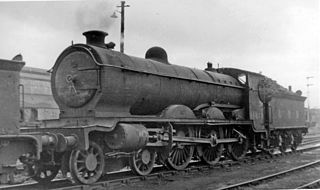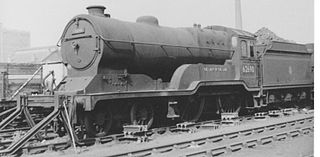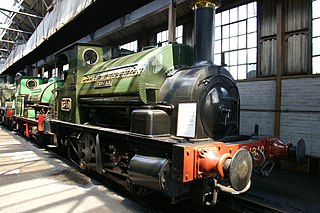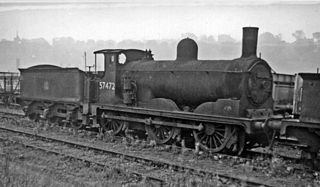John George Robinson CBE, was an English railway engineer, and was chief mechanical engineer of the Great Central Railway from 1900 to 1922.

The Caledonian Railway 60 Class were 4-6-0 passenger engines designed by William Pickersgill and introduced in 1916. Six were built by the Caledonian Railway at its own St. Rollox works in 1916–17, and all of them passed into LMS ownership in 1923. A further twenty locomotives of a slightly modified design were built by the LMS under the auspices of George Hughes in the period of 1925–1926.

The Great Central Railway (GCR) Class 8K 2-8-0 is a class of steam locomotive designed for heavy freight. Introduced in 1911, and designed by John G. Robinson, 126 were built for the GCR prior to the First World War. Including wartime construction for the British Army ROD and the post-war GCR Class 8M, the class and its derivatives totalled 666 locomotives.

The London and North Eastern Railway (LNER) Class O4 initially consisted of the 131 ex-Great Central Railway (GCR) Class 8K 2-8-0 steam locomotives acquired on grouping in 1923. The engines were designed by John G. Robinson and built at the GCR's Gorton Locomotive Works, Manchester.

The NBR C Class is a class of 0-6-0 steam locomotives designed by Matthew Holmes for freight work on the North British Railway (NBR). They were introduced in 1888 with inside cylinders and Stephenson valve gear. A total of 168 locomotives was built, of which 123 came into British Railways ownership at nationalisation in 1948. This was the last class of steam engine in service in Scotland.

The Great Central Railway Class 11F or Improved Director Class is a class of 4-4-0 steam locomotive designed by John G. Robinson for passenger work. The LNER classified them as Class D11 from 1923. They were based on the earlier GCR Class 11E "Director" class.

The Caledonian Railway 72 Class was a class of 4-4-0 steam locomotives introduced by William Pickersgill for the Caledonian Railway (CR) in 1920. Thirty-two locomotives were built and all survived to be taken over by the London, Midland and Scottish Railway (LMS) in 1923 and by British Railways (BR) in 1948. The earlier 113 Class, of which 16 were produced, were similar but slightly smaller. These were the Caledonian's last express passenger locomotives, and technically, the last of the Dunalastair series, and were unofficially dubbed, Dunalastair V.

The Great Central Railway Class 9N, classified A5 by the LNER, was a class of 4-6-2 tank locomotives designed by John G. Robinson for suburban passenger services. They were fitted with superheaters, piston valves and Stephenson valve gear.

The Great Central Railway (GCR) Class 9F was a class of 0-6-2T steam locomotive built between 1891 and 1901. From 1923 the locomotives were redesignated Class N5.

The London and North Eastern Railway Class U1 was a solitary 2-8-0+0-8-2 Garratt locomotive designed for banking coal trains over the Worsborough Bank, a steeply graded line in South Yorkshire and part of the Woodhead Route. It was both the longest and the most powerful steam locomotive ever to run in Britain. It was built in 1925 with the motion at each end being based on an existing 2-8-0 design. The original number was 2395, and it was renumbered 9999 in March 1946, and then 69999 after nationalisation in 1948, although it retained its cab-side plate bearing its original number throughout its life. The locomotive ran for some time as an oil burner, and was tried out on the Lickey Incline in 1949–1950 and again, after the electrification of its home line, in 1955. These trials were unsuccessful, and so the locomotive was withdrawn in 1955 and scrapped.

The GWR 0-4-0ST steam locomotives were acquired by the Great Western Railway at the 1923 grouping. They came from small railways and from contractors. Some of them survived into British Railways ownership in 1948 and a few are preserved.

The GCR Class 11E was a type of 4-4-0 steam locomotive used by the Great Central Railway for express passenger services. Ten were built in the railway's own workshops at Gorton, Manchester during 1913; they remained in service until the mid-1950s.

The H&BR Class G3 was a class of 0-6-0T steam locomotives of the Hull and Barnsley Railway (H&BR). The H&BR became part of the North Eastern Railway (NER) in 1922 and the NER became part of the London and North Eastern Railway (LNER) in 1923.

The GER Class G69 was a class of twenty 2-4-2T steam locomotives built by for the Great Eastern Railway by S. D. Holden in 1911–12 following the design of two rebuilt examples of the GER Class M15 designed by James Holden, his father, in 1904. They all passed to the London and North Eastern Railway at the 1923 grouping and received the classification F6.

The GER Class M15 was a class of 160 2-4-2T steam locomotives designed by Thomas William Worsdell and built for the Great Eastern Railway between 1884 and 1909. The original (F4) class of locomotives were fitted with Joy valve gear which was notoriously difficult to 'set'. This earned them the nickname of 'Gobblers' thanks to their high coal consumption rates. As a result, between 1911 and 1920, 32 of them were rebuilt by James Holden with Stephenson valve gear and higher pressure boilers. Despite this, the nickname stuck for many years after.

The GCR Classes 9D, 9H and 9M were a class of 124 0-6-0 Steam locomotives designed by Harry Pollitt for freight work on the Manchester, Sheffield and Lincolnshire Railway (MS&LR) later renamed Great Central Railway (GCR).

The L&YR Class 31 was a class of 0-8-0 steam locomotives of the Lancashire and Yorkshire Railway. The class was designed by George Hughes and introduced in 1912. The class comprised 115 new locomotives and 40 rebuilt from other classes.

The Caledonian Railway 294 and 711 Classes were 0-6-0 steam locomotives designed by Dugald Drummond for the Caledonian Railway (CR) and introduced in 1883. After Drummond's retirement, construction of the class continued under Smellie, Lambie and McIntosh.
GCR Class 8G was a class of 10 two-cylinder steam locomotives of the 4-6-0 wheel arrangement built in 1906 for the Great Central Railway.

















